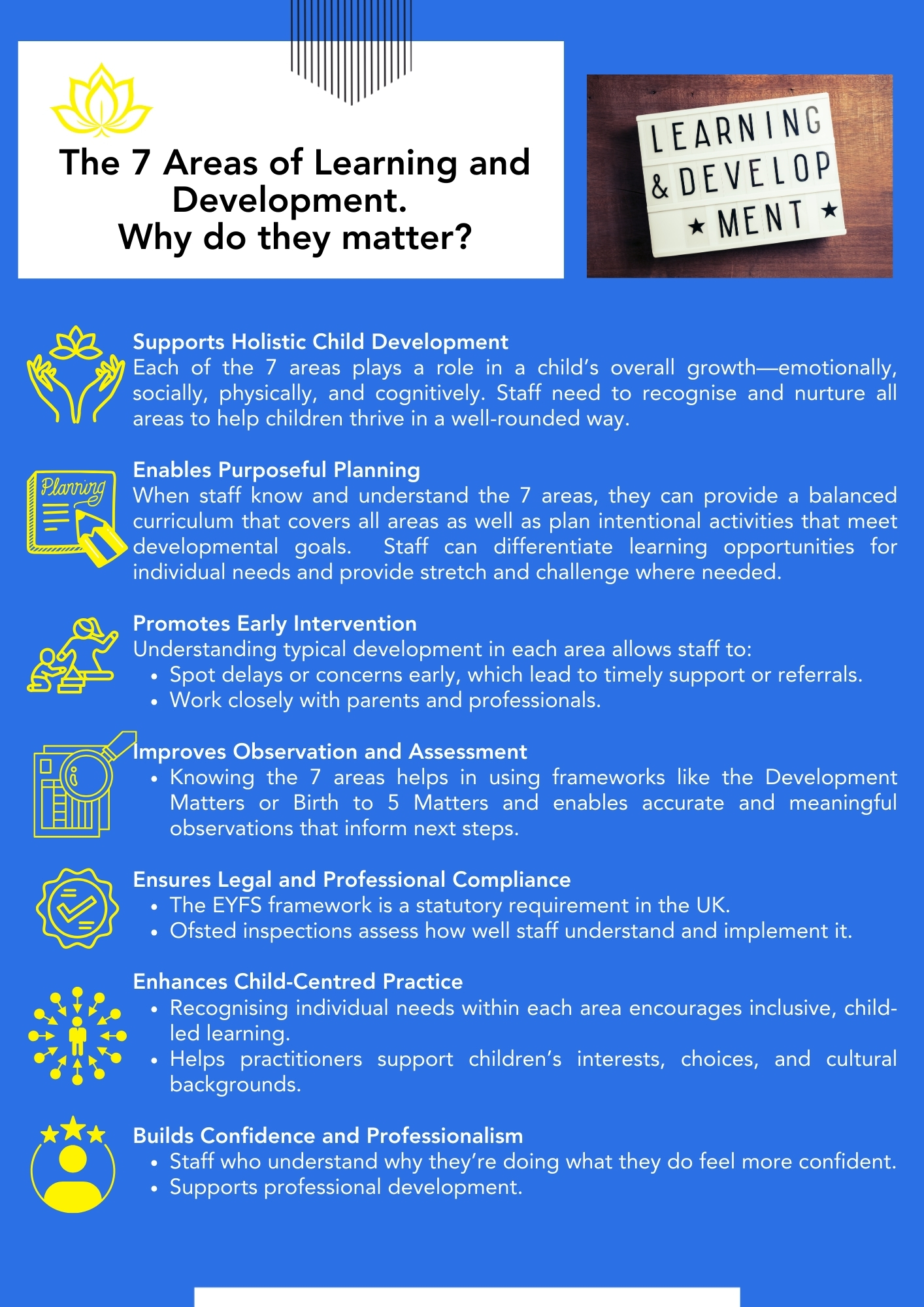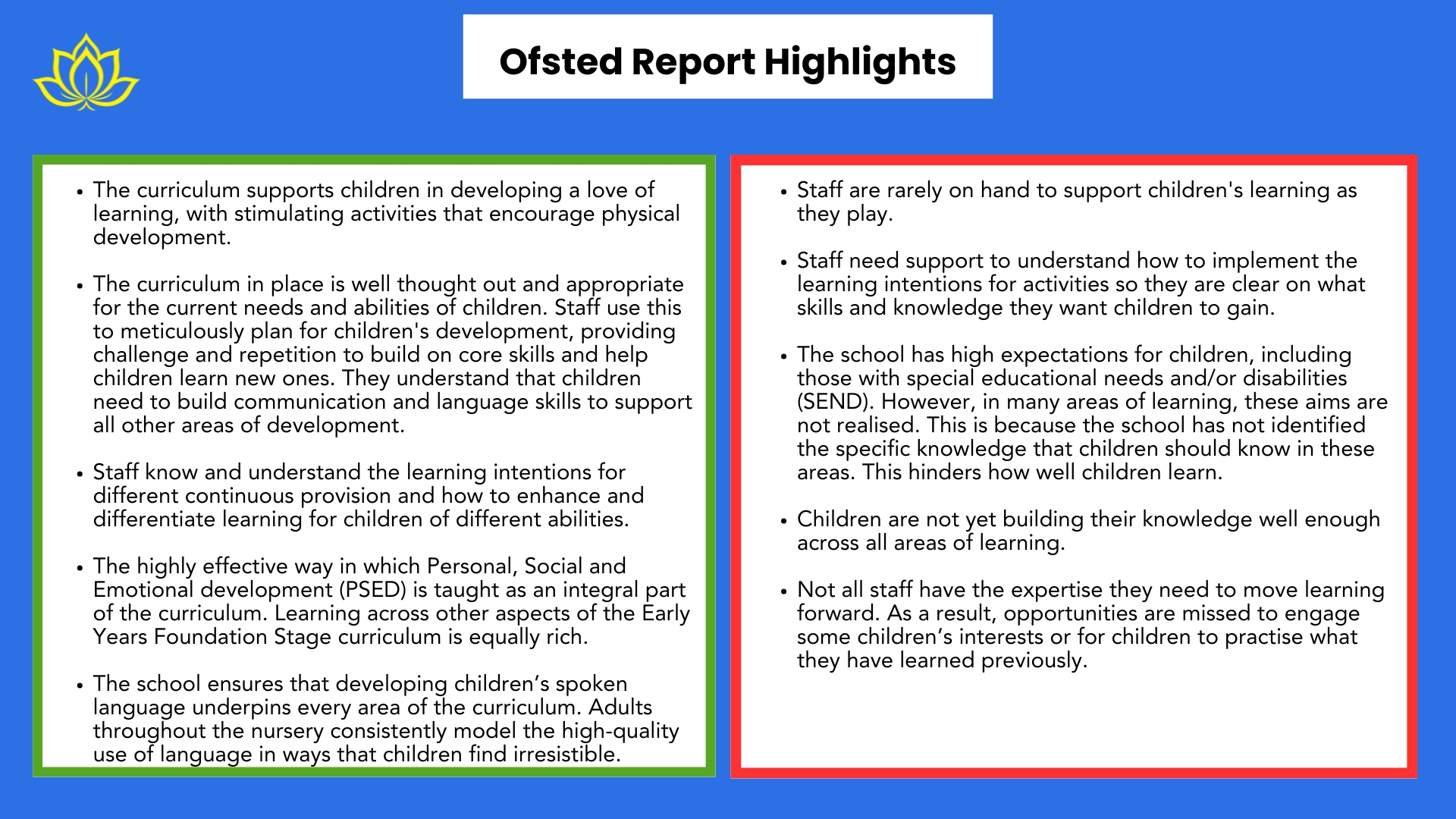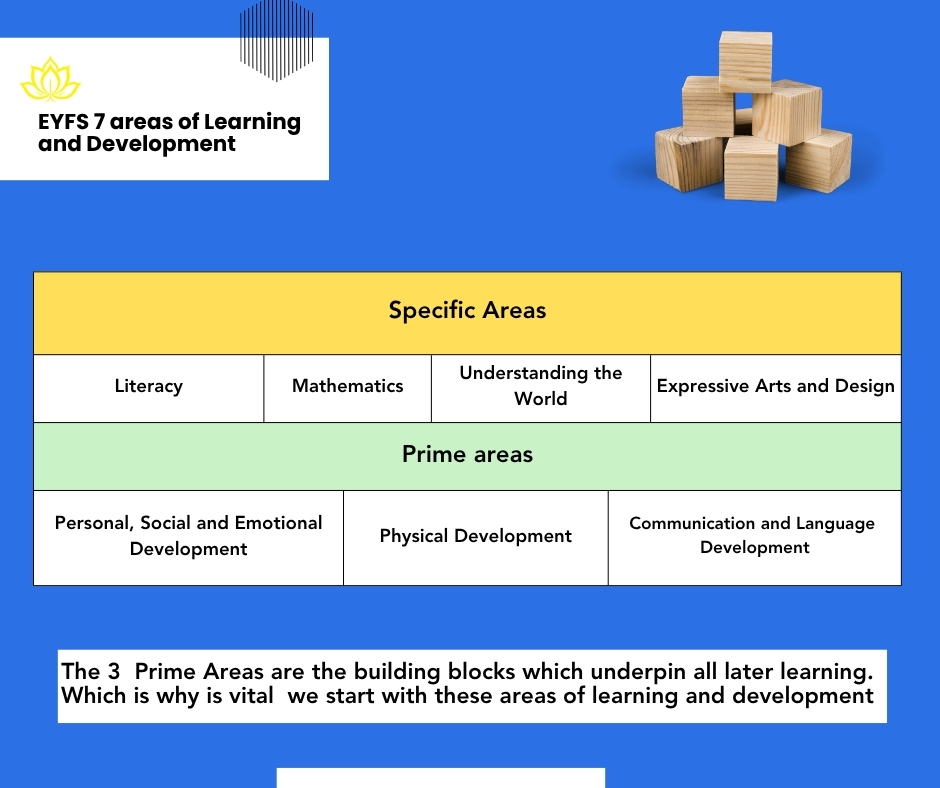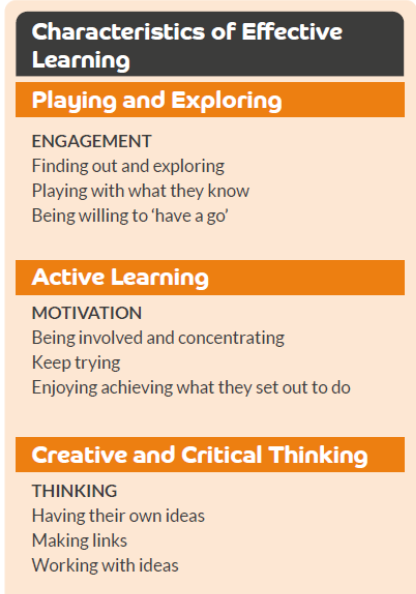A setting who gets this right will…
- Have staff that know and understand the 7 areas of learning and understand the areas of development.
- Staff will understand that the Prime Areas are the building blocks to the Specific Areas.
- Have staff that plan and implement activities for the children that stretch and challenge them in all areas of the curriculum.
- Have staff that promote a child centred approach.
Why does this matter?

The wider the range of possibilities we offer children, the more intense will be their motivations and the richer their experiences.
Louis Malaguzzi
Education is a holistic endeavour that involves the whole person, including our bodies, in a process of formation that aims our desires, primes our imagination, and orients us to the world – all before we ever start ‘thinking’ about it.
James K. A. Smith
What do Ofsted Reports capture?

The 7 areas of Learning
| Areas of Learning and Development | |||||
| Prime areas | |||||
| Personal, Social and Emotional Development | Physical Development | Communication and Language Development | |||
| Making Relationships Self Confidence and Self Awareness Managing Feelings and Behaviour | Moving and Handling Health and Self Care | Listening and Attention Understanding Speaking | |||
| Specific Areas | |||||
| Literacy | Mathematics | Understanding the World | Expressive Arts and Design | ||
| Reading Writing | Numbers Space, Shape and Measures | People and Communities The World Technology | Creating with Materials Being Imaginative | ||
These are the building blocks of learning:
- The 3 prime areas are particularly important for learning and forming relationships. This is the foundation for children to build up to enable them to thrive and provide the basis for learning in all areas.
- We must also support children in four specific areas, which help strengthen and develop the three prime areas, and ignite children’s curiosity and enthusiasm.
Task one – Reflect on where you are today
Which of these statements best captures your current practice…
- Exemplary promotion of seven areas of learning in all they do which impacts all children in the whole setting.
- Opportunities to develop the seven areas of learning are consistently implemented.
- Inconsistent development opportunities around the seven areas or learning.
- Very little development opportunities around the seven areas or learning.
Discuss this with your colleagues and encourage them to reflect too. If you are at different stages, how can you help one another to improve?
What does each Prime area mean?
Communication and Language – The development of children’s spoken language underpins all seven areas of learning and development. Children’s back-and-forth interactions from an early age form the foundations for language and cognitive development. The number and quality of the conversations they have with adults and peers throughout the day in a language-rich environment is crucial.
PSED – Children’s personal, social and emotional development (PSED) is crucial for children to lead healthy and happy lives and is fundamental to their cognitive development. Underpinning their personal development are the important attachments that shape their social world.
Physical – Physical activity is vital in children’s all-round development, enabling them to pursue happy, healthy and active lives. Gross and fine motor experiences develop incrementally throughout early childhood, starting with sensory explorations and the development of a child’s strength, co-ordination and positional awareness through tummy time, crawling and play movement with both objects and adults.

How do we promote the prime areas?
Communication and Language – By commenting on what children are interested in or doing, and echoing back what they say with new vocabulary added, practitioners will build children’s language effectively. Reading frequently to children, and engaging them actively in stories, non-fiction, rhymes and poems, and then providing them with extensive opportunities to use and embed new words in a range of contexts, will give children the opportunity to thrive. Through conversation, storytelling and role play, where children share their ideas with support and modelling from their teacher, and sensitive questioning that invites them to elaborate, children become comfortable using a rich range of vocabulary and language structures.
PSED – Strong, warm and supportive relationships with adults enable children to learn how to understand their own feelings and those of others. Children should be supported to manage emotions, develop a positive sense of self, set themselves simple goals, have confidence in their own abilities, to persist and wait for what they want and direct attention as necessary. Through adult modelling and guidance, they will learn how to look after their bodies, including healthy eating, and manage personal needs independently. Through supported interaction with other children, they learn how to make good friendships, co-operate and resolve conflicts peaceably. These attributes will provide a secure platform from which children can achieve at school and in later life.
Physical – By creating games and providing opportunities for play both indoors and outdoors, adults can support children to develop their core strength, stability, balance, spatial awareness, co-ordination and agility. Gross motor skills provide the foundation for developing healthy bodies and social and emotional well-being. Fine motor control and precision helps with hand-eye co-ordination, which is later linked to early literacy. Repeated and varied opportunities to explore and play with small world activities, puzzles, arts and crafts and the practice of using small tools, with feedback and support from adults, allow children to develop proficiency, control and confidence.
What does each Specific area mean?
Literacy – It is crucial for children to develop a life-long love of reading. Reading consists of two dimensions: language comprehension and word reading. Language comprehension (necessary for both reading and writing) starts from birth. It only develops when adults talk with children about the world around them and the books (stories and non-fiction) they read with them, and enjoy rhymes, poems and songs together.
Maths – Developing a strong grounding in number is essential so that all children develop the necessary building blocks to excel mathematically. Children should be able to count confidently, develop a deep understanding of the numbers to 10, the relationships between them and the patterns within those numbers.
Understanding the World – Understanding the world involves guiding children to make sense of their physical world and their community.
Expressive arts and design – The development of children’s artistic and cultural awareness supports their imagination and creativity. It is important that children have regular opportunities to engage with the arts, enabling them to explore and play with a wide range of media and materials.
How do we promote Specific areas?
Literacy – Language comprehension (necessary for both reading and writing) starts from birth. It only develops when adults talk with children about the world around them and the books (stories and non-fiction) they read with them, and enjoy rhymes, poems and songs together. Skilled word reading, taught later, involves both the speedy working out of the pronunciation of unfamiliar printed words (decoding) and the speedy recognition of familiar printed words. Writing involves transcription (spelling and handwriting) and composition (articulating ideas and structuring them in speech, before writing).
Maths – By providing frequent and varied opportunities to build and apply this understanding – such as using manipulatives, including small pebbles and tens frames for organising counting – children will develop a secure base of knowledge and vocabulary from which mastery of mathematics is built. In addition, it is important that the curriculum includes rich opportunities for children to develop their spatial reasoning skills across all areas of mathematics including shape, space and measures. It is important that children develop positive attitudes and interests in mathematics, look for patterns and relationships, spot connections, ‘have a go’, talk to adults and peers about what they notice and not be afraid to make mistakes.
Understanding the World – The frequency and range of children’s personal experiences increases their knowledge and sense of the world around them – from visiting parks, libraries and museums to meeting important members of society such as police officers, nurses and firefighters. In addition, listening to a broad selection of stories, non-fiction, rhymes and poems will foster their understanding of our culturally, socially, technologically and ecologically diverse world. As well as building important knowledge, this extends their familiarity with words that support understanding across domains. Enriching and widening children’s vocabulary will support later reading comprehension.
Expressive arts and design – The quality and variety of what children see, hear and participate in is crucial for developing their understanding, self-expression, vocabulary and ability to communicate through the arts. The frequency, repetition and depth of their experiences are fundamental to their progress in interpreting and appreciating what they hear, respond to and observe.
Considerations from the EYFS
Practitioners should be ambitious for all children. To do this they must:
- Consider the individual needs, interests, and development of each child in their care.
- Use this information to plan a challenging and enjoyable experience for each child in all areas of learning and development.
- Ensure a strong foundation for children’s development in the three prime areas.
- Recognise that the specific areas provide opportunities to strengthen and apply the prime areas of learning and are particularly important in developing language and extending vocabulary.
The EYFS framework does not prescribe a particular teaching approach.
Play is essential for children’s development, building their confidence as they learn to explore, relate to others, set their own goals, and solve problems.
Children learn by leading their own play, and by taking part in play and learning that is guided by adults.
Practitioners need to decide what they want children in their setting to learn, and the most effective ways to teach it.
Practitioners must stimulate children’s interests, responding to each child’s emerging needs and guiding their development through warm, positive interactions coupled with secure routines for play and learning.
Characteristics of effective learning
In planning and guiding what children learn, practitioners must reflect on the different rates at which children are developing and adjust their practice appropriately. This is achieved through using the Three characteristics of effective teaching and learning:
- Playing and exploring – children investigate and experience things, and ‘have a go’.
- Active learning – children concentrate and keep on trying if they encounter difficulties and enjoy achievements.
- Creating and thinking critically – children have and develop their own ideas, make links between ideas, and develop strategies for doing things.

Linking areas of learning to planning
[You won’t thank me for saying it but I think we need to get a video in here, perhaps these slides on holistic development and planning could be shared with one of the team to give it a go, or make the script for them too? Let’s discuss]
[Perhaps more tasks are needed?]
GIST – Good ideas for starting things…
- Reflective Practice Audit
- Think about each of the 7 areas of the EYFS and score yourself from 1-5 on how confident they feel in supporting each area
- This can be done with sticky notes, or an online poll.
- This encourages reflection, and helps participants identify where they need to develop and improve
- Reflecting on Observations
- Look back through your observations, do they only link to certain areas of the EYFS? Is this because your key children only spend time there or because you avoid or lack confidence in certain areas?
- Apply the same question to when you are planning activities for your key children
- Environment Walkabout (Learning Walk)
- Walk around your room and imagine you are showing a parent/new member of staff around the room and talk to them about the different areas and reflect:
- Could you easily describe and point out all 7 areas.
- Which areas feel strongest? Which are less obvious? – Were there any areas that you were embarrassed about?
- Think of small tweaks (e.g., adding labels to promote literacy, loose parts play for maths, or cosy spaces for communication).
- Child-Centred
- Begin with a case study, short video, or story of a child engaging in play (ideally in your setting)
- Identify which of the 7 areas are being supported in that single activity.
Want to learn more?
- This guidance from Blossom will help explore the areas in more detail.
- This guidance from PACEY considers areas of best practice when delivering the prime and specific areas of learning.
- The government have some helpful guidance resources accessible here.
